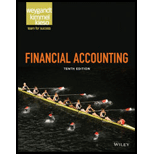
Concept explainers
Assets:
Assets are the resources owned by a business to carry out production and sales activities. The assets are associated with a future economic value that can be expressed in terms of monetary values. All the assets are meant to provide future services or benefits. Examples include cash,
Liabilities:
Liabilities are the obligations against assets that are to be fulfilled in the future. Most of the businesses borrow money or buy goods and services from a supplier on credit. This incurs a future obligation on the businesses, which is to be fulfilled in the future. Examples include loans payable, interest payable, accounts payable, wages payable, etc.
The amount invested to a business by its shareholder or the donated capital and earnings from operations less any dividends issued gives the stockholders’ equity. The stockholders’ equity gives the ownership claim on the total assets of a business. The amount left after satisfying the creditors, belongs to the stockholders’ claim on the assets. It also includes common stock and
Debits and Credits:
The term ‘debit’ represents the left side of an account and the term ‘credit’ represents the right side of the account. In the accounting process, the increase in cash is recorded as debits and the decrease in cash as credits. Thus, an increase in cash or asset is recorded on the left side and a decrease in cash or liabilities is recorded on the right side of the account.
Since, both the sides of the
The normal balance of an account is recorded on the side where an increase in the account is observed. Therefore, the normal balance is recorded on the debit side, if the balance in the debit side exceeds the balance on the credit side and vice-versa.
To indicate: Whether each of the following accounts is an asset, liability, stockholder’s equity account and whether it has normal debit and credit balances.
Want to see the full answer?
Check out a sample textbook solution
Chapter 2 Solutions
Financial Accounting
- Synergy Works had a Work-in-Process balance of $160,000 on January 1, 2023. The year-end balance of Work-in-Process was $142,000, and the Cost of Goods Manufactured was $795,000. Use this information to determine the total manufacturing costs incurred during the fiscal year 2023.arrow_forwardPlease provide the solution to this general accounting question using proper accounting principles.arrow_forwardHi expert please given correct answer with accounting questionarrow_forward

 AccountingAccountingISBN:9781337272094Author:WARREN, Carl S., Reeve, James M., Duchac, Jonathan E.Publisher:Cengage Learning,
AccountingAccountingISBN:9781337272094Author:WARREN, Carl S., Reeve, James M., Duchac, Jonathan E.Publisher:Cengage Learning, Accounting Information SystemsAccountingISBN:9781337619202Author:Hall, James A.Publisher:Cengage Learning,
Accounting Information SystemsAccountingISBN:9781337619202Author:Hall, James A.Publisher:Cengage Learning, Horngren's Cost Accounting: A Managerial Emphasis...AccountingISBN:9780134475585Author:Srikant M. Datar, Madhav V. RajanPublisher:PEARSON
Horngren's Cost Accounting: A Managerial Emphasis...AccountingISBN:9780134475585Author:Srikant M. Datar, Madhav V. RajanPublisher:PEARSON Intermediate AccountingAccountingISBN:9781259722660Author:J. David Spiceland, Mark W. Nelson, Wayne M ThomasPublisher:McGraw-Hill Education
Intermediate AccountingAccountingISBN:9781259722660Author:J. David Spiceland, Mark W. Nelson, Wayne M ThomasPublisher:McGraw-Hill Education Financial and Managerial AccountingAccountingISBN:9781259726705Author:John J Wild, Ken W. Shaw, Barbara Chiappetta Fundamental Accounting PrinciplesPublisher:McGraw-Hill Education
Financial and Managerial AccountingAccountingISBN:9781259726705Author:John J Wild, Ken W. Shaw, Barbara Chiappetta Fundamental Accounting PrinciplesPublisher:McGraw-Hill Education





